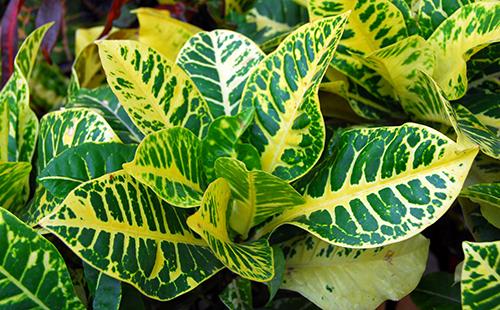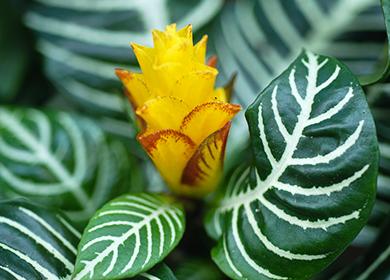The content of the article
Croton is a decorative deciduous perennial. The foliage is bright, large. The shape of the leaves varies between different varieties. Depending on the age of each individual leaf, it can be pale green, warm yellow, orange or deep red. Young leaves are green, change color as they grow. But the flowers of Croton are plain and inconspicuous. Therefore, it is grown exclusively for beautiful foliage.
Description and Features
The genus includes about 15 species. Among them there are trees and shrubs. All of them belong to evergreens. The stems are semi-lignified. The leaves are diverse in shape and color, large, leathery. The shape is lobed, the surface is smooth, glossy. The location on the shoots is alternate. The stems are straight or with branching.
The shape of the leaves is different - oval, with ragged edges, pointed, spirally twisted. Coloring mottled, different colors with spots, bright veins, dots. Due to the nature of changing the color of leaves depending on age, there is often confusion with the varieties. Bright colors remain throughout the year.
The average size of the indoor croton is from 50 to 70 cm. The flowers of the croton are yellowish, small, nondescript. Inflorescences in the form of long hanging brushes are formed in the upper nodes of the shoots. The apartments usually do not bloom.
If flower stalks begin to form, they are usually immediately cut off. Flowering weakens the plant, reduces its decorativeness. If you decide to leave the buds, care for the croton after flowering should be aimed at restoring the forces of the plant - systematic watering, regular feeding.
Indoor Varieties
As a room potted plant, mainly motley croton, its varieties and hybrid varieties are grown. He adapts better than others to the conditions of the apartment, grows not so big, gratefully responds to good care. The following variegated croton species are especially popular.
- Genuinny. Foliage lanceolate, narrowed at the base. Color - a beautiful silver pattern along the main vein.
- Oval leaf. The shape of the leaves is oval, rounded from the base and tip. Also characteristic is the pattern along the central vein. It features a beautiful golden color.
- Decorated. The leaves are oval, more elongated than the oval-leaf croton.
- Three way. Custom foliage form in three parts. Along the veins are golden yellow stripes.
- Tortoiseshell. Leaves are three-colored. The main tone is olive. Veins are red with golden yellow spots and a strip passing along them.
Croton Care: Things to Consider
How to care for a croton in a pot? The plant is unpretentious and easy to maintain.For all varieties of croton adhere to the same rules of care.
- Lighting. To preserve the unusual color of the foliage, the plant is kept in a place rich in sunshine. Excess light negatively affects decorativeness - leaves get burned, the picture "fades." The optimal location is the windowsills of the western or eastern windows.
- Temperature. It is important to maintain the correct temperature. In summer, the air temperature in the room should not rise above 25 ° C. In winter - fall below 16 ° C. Croton does not tolerate drafts, so even in warm weather they do not rearrange it on the balcony. In winter, the flower pot is fenced off from the glass with insulation materials.
- Watering. The plant is relatively hygrophilous, but does not tolerate prolonged waterlogging. For full growth, stable humidity is maintained - without gulf and drying out. Errors in watering mode lead to the death of foliage. You can not use cold water - at any time of the year use water at room temperature. In winter, it is watered sparingly, in summer - abundantly.
- Humidity. Spraying is beneficial to croton. In humid air, foliage becomes brighter, more expressive. Sun exposure to the leaves during spraying is avoided. Additionally, humidity is increased by arranging water pots around the pot using special humidifiers.
- The soil. Use universal soil for decorative and deciduous plants. The main soil requirements are lightness and breathability. An independently suitable mixture can be made up of sand, peat, turf, rotted compost and deciduous land. It is advisable to include crushed birch charcoal in the composition.
- Transfer. If the croton is not transplanted in time, the growth will slow down, the leaves will begin to fall. It grows fast. A young plant may need up to two transplants per year. Preference is given to the transshipment method so as not to injure the root system. The lumps of the earth are not destroyed, the flower with it is rearranged into a larger pot, and fresh soil is added.
- Top dressing. In summer they feed weekly. Organic fertilizers alternate with mineral ones. In winter, you can feed no more than once a month. The concentration of top dressing in the winter is halved.
Breeding methods
Croton propagated by seeds, cuttings and aerial layering. The vegetative method is used more often - it allows you to quickly get an ornamental plant without losing the characteristics of the variety. The complexity of seed reproduction - croton rarely blooms in apartments, it is problematic to get seeds from it.
Cuttings
Description. The easiest way is to root the croton with cuttings. The apical and stem parts are used. The main requirement for the handle is the presence of at least one sleeping axillary kidney and a leaf fragment. Cuttings can be cut at any time of the year.
Procedure
- Cuttings are cut up to 10 cm long. Slices are sprinkled with coal powder.
- Cuttings are immersed in water for an hour to remove milky juice. Large leaves are cut in half, lower ones are completely removed.
- For two hours, the cuttings are dried and put in warm water with the addition of a rooting agent. Immerse only the tip. The temperature is maintained at 25-30 ° C.
- Immediately after the appearance of the roots, the cuttings are transplanted into the ground. It’s not worth pulling with a landing - long roots break easily.
Air layering
Description. Judging by the reviews, this is one of the most effective ways to reproduce croton. The risk of decay of the cuttings in water is completely eliminated. Air layers are obtained from adult plants with lignified stems. Reproduction by layering requires certain skills, but it is quite simple.
Procedure
- Choose a healthy sturdy bark-covered shoot.
- At a height of about 10 cm from the top of the stem, two circular incisions are made to the depth of the bark. The distance between the cuts is about 1 cm.
- A strip of bark is removed, the prepared area is treated with a rooting agent solution. The place of cut is wrapped with wet sphagnum, fixed with polyethylene.
- Moss is periodically moistened. After the roots grow back, the branch is cut and planted in the ground.
Seeds
Description. Growing croton from seeds at home is a laborious, lengthy process. For sowing take store seeds. They quickly lose their germination, so it is recommended to carefully look at the date of packing of the seeds. They are sown after preliminary preparation in late winter or early spring.
Procedure
- Croton seeds for half an hour pour a weakly concentrated solution of potassium permanganate. Water is taken very warm. Another day the seeds are kept in water with the addition of a growth activator.
- The container is filled with a loose, previously calcined in the oven, substrate. The surface of the soil is moistened with a spray gun, the seeds are pressed to a depth of about one centimeter.
- The container is covered with a film, the temperature is maintained at 22-25 ° C. Shoots will appear in a month.
- At the stage of three real leaves, seedlings can be planted in separate pots. Subsequent transplants are performed as they grow.
Common diseases
Croton is rarely ill. Most diseases of indoor plants bypass it. The diseases that flower growers have to deal with and their treatment are shown in the table.
Table - Croton Diseases
| Disease name | Main signs | Treatment methods |
|---|---|---|
| Anthracnose | - The appearance of reddish or gray spots; - leaf wilting | - Decrease in air humidity; - decrease in the frequency of irrigation; - plant isolation; - spraying with drugs "Fundazol", "Euparen" |
| Root rot | - loss of gloss leaves; - yellowness and wilting of leaves; - softening, rot of roots | - Dry maintenance; - transplantation into a coarse-grained substrate; - root system treatment with Alirin-B, Fitosporin-M preparations |

Typical pests
Pests cause more problems. Over-dried air, high soil moisture, and proximity to infected plants contribute to their appearance. The pests that have to be faced, and methods of dealing with them are indicated in the table.
Table - Croton Pests
| Insect name | Signs of infection | Control measures |
|---|---|---|
| Shield | - The appearance of bright spots; - the appearance of convex brown plaques; - the formation of a transparent adhesive coating | - Isolation of the plant; - treatment of leaves and stems with alcohol; - spraying with insecticides |
| Aphid | - Twisting the tops of the shoots; - formation of sticky plaque; - yellowing of leaves | - Washing the plants with soap and water; - insecticide treatment |
| Spider mite | - The formation of light specks on the leaves; - drying leaves; - webbing | - Processing with soap or mineral oil; - spraying with acaricides |
| Worms | - The appearance of a waxy white coating on the petioles and veins of leaves | - Spraying with mineral oil; - spraying with insecticides |
| Multi-claw ticks | - Lack of growth; - twisting, coarsening of the tops of the shoots; - formation of brown scabs on petioles | - Processing with preparations "Vermitek", "Acarin", "Lightning" |
Violation of the conditions of detention
In addition to diseases, the decorative effect of croton may suffer due to improper conditions of detention. Lack of moisture, excess sun, dry air, poor drainage - all this leads to a number of problems. All of them are given in the table.
Table - Signs of violation of the content of croton
| Problem | Possible reasons | Solutions |
|---|---|---|
| Croton leaves dry and fall | - Falling of the lower leaves - a natural phenomenon; - dry air; - constant drafts; - insufficient watering; - frequent temperature changes | - Adjust the irrigation mode; - regularly sprayed |
| Stains appear on the leaves | - Sunburn; - anthracnose; - pests; - cold | - Establish a reason; - from pests sprayed with insecticides; - with anthracnose, fungicides are used |
| Croton lowered the leaves | - Cold to the roots; - small volume of the pot; - no watering | - Keep in a warm place; - if necessary, transplanted; - regularly watered |
| The tips of the leaves are dry | - dry air | - Regularly sprayed |
If the care for the croton is organized correctly, the flower will quickly grow and form a lush bush. Croton looks beautiful in spacious rooms, decorates the interior with colorful, vibrant foliage.

